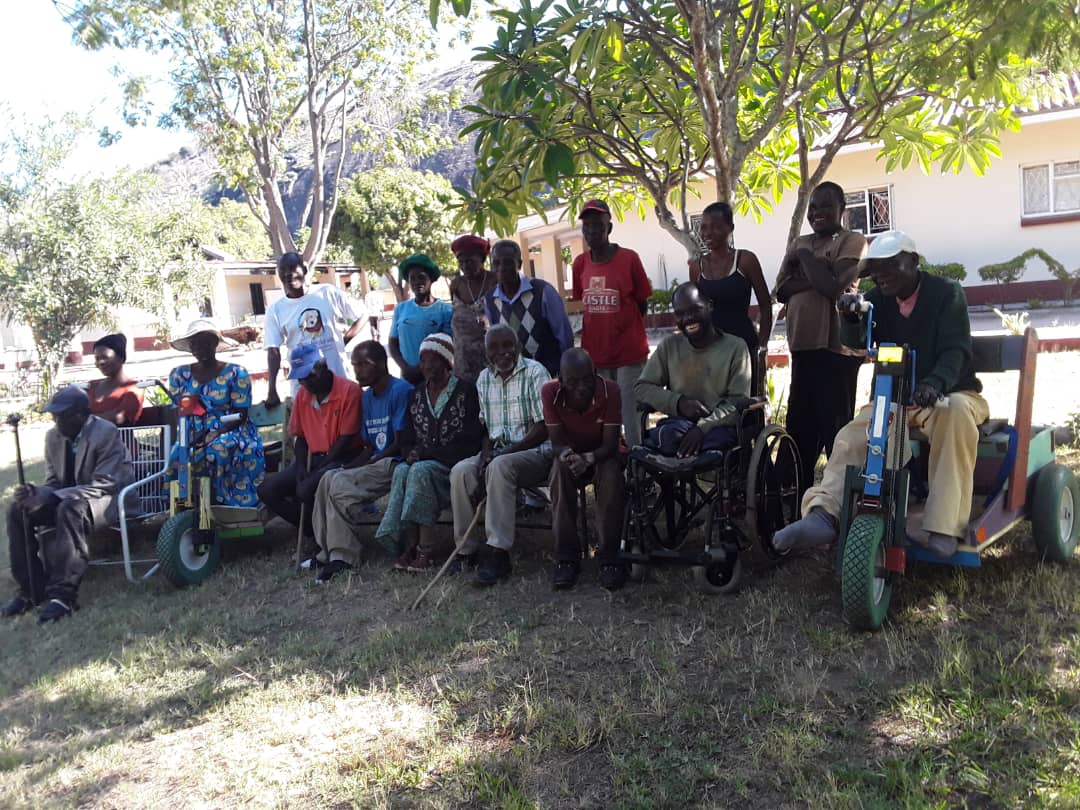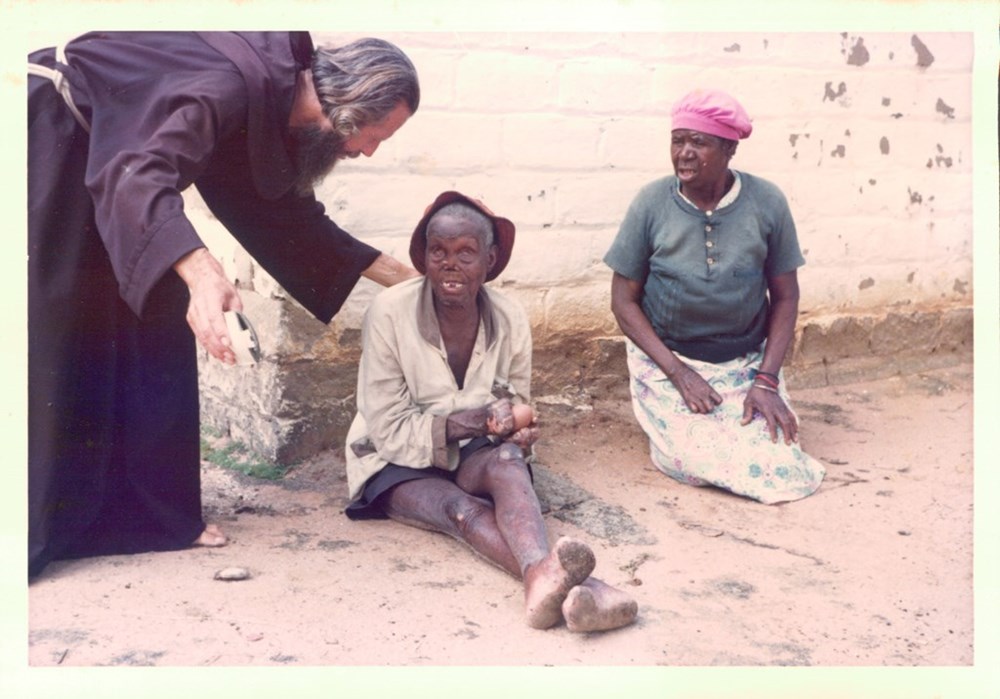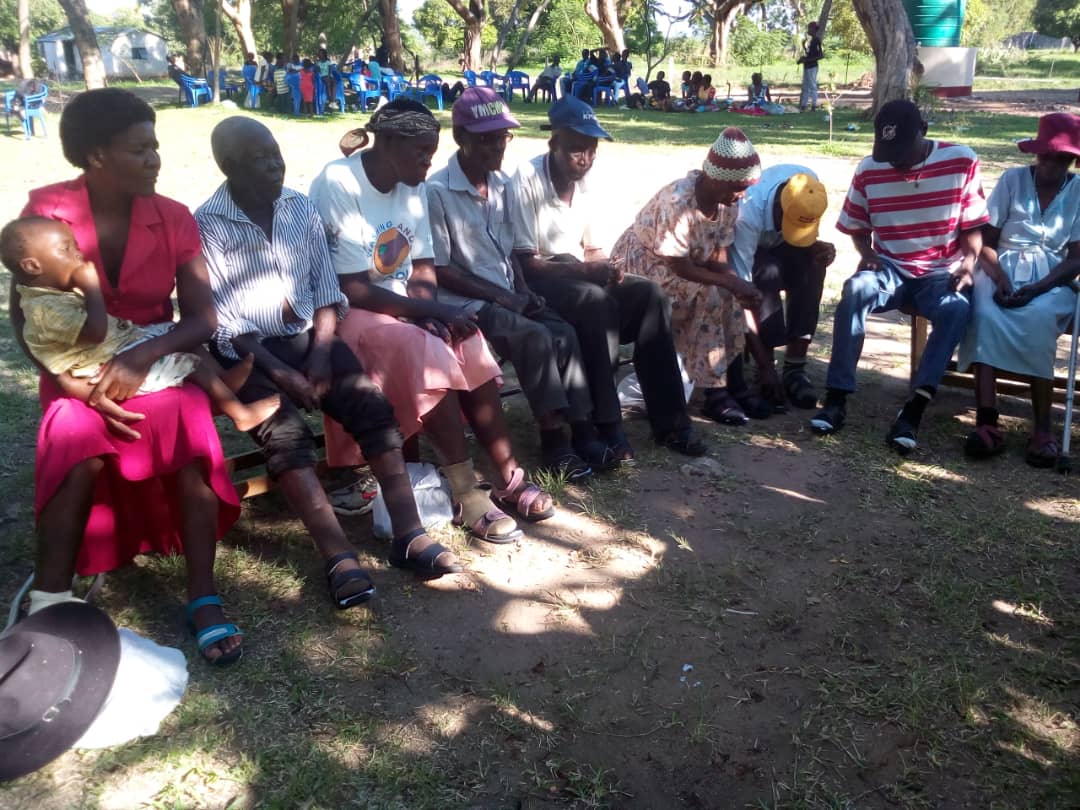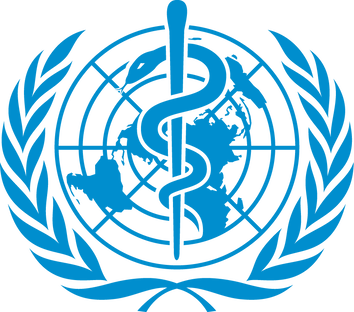PRESS RELEASE
Date: 8 July 2021
Date: 8 July 2021
Leprosy Charity funds Mutemwa Leprosy Care Centre, Zimbabwe
SFLG gives emergency relief during COVID-19 pandemic
SFLG gives emergency relief during COVID-19 pandemic
London, UK: St Francis Leprosy Guild is delighted to announce that it will support the Mutemwa Leprosy Care Centre in Mutoko, Zimbabwe. In addition to a share of £60,000 COVID-19 pandemic emergency relief, SFLG will provide a new solar pump and repair the crucial water supply network.
The water is sourced from the Mother of Peace Orphanage dam next to the Leprosy Care Centre. The supply is used for irrigation and maintenance of the gardens, vegetable and flower production and supplying water to the pigs, cattle, chickens, and other livestock.
Mutemwa (meaning outcast in Shona, the local language) is a well-established and highly regarded leprosy care centre. It is home to over 50 elderly residents, people affected by leprosy, leprosy disability and who are outcast from society. Mutemwa sees around one thousand outpatients per year and supports others who are homeless and destitute.
The centre provides physical, material, psychological and emotional care to post-leprosy sufferers, the physically and mentally challenged and the destitute. It is working towards self-sufficiency through farming, rearing poultry, pigs and cattle and a shop.
The water is sourced from the Mother of Peace Orphanage dam next to the Leprosy Care Centre. The supply is used for irrigation and maintenance of the gardens, vegetable and flower production and supplying water to the pigs, cattle, chickens, and other livestock.
Mutemwa (meaning outcast in Shona, the local language) is a well-established and highly regarded leprosy care centre. It is home to over 50 elderly residents, people affected by leprosy, leprosy disability and who are outcast from society. Mutemwa sees around one thousand outpatients per year and supports others who are homeless and destitute.
The centre provides physical, material, psychological and emotional care to post-leprosy sufferers, the physically and mentally challenged and the destitute. It is working towards self-sufficiency through farming, rearing poultry, pigs and cattle and a shop.
How could we not help? said SFLG Chief Executive Officer, Clare McIntosh. People with leprosy are so often abandoned by society. With no social services, a diagnosis of leprosy often means a life of begging on the streets to survive.
At an age when many people in developed countries are enjoying their retirement, older people with leprosy face some horrific challenges. I am just glad that SLFG can make a difference and that is thanks to the generosity of our donors.
Mutemwa is often known for the astonishing life its former warden, John Bradburne.
I believe John was a huge inspiration, not only to the Mutemwa community but far afield and beyond. His stoic determination to “stay put” at Mutemwa, while continuing his daily tasks of caring for his friends physically, emotionally and spiritually with kindness and compassion was brave and inspiring” said Teresa Yonge, John Bradburne’s niece.
His refusal to abandon those living with leprosy at Mutemwa, while the civil war of independence was raging throughout the Mutoko area, must have made those at Mutemwa feel valued, loved and protected in some way. John was simply continuing the way forward, through his steadfast faith, following Jesus’ example of unconditional love.
The Mutemwa residents and The John Bradburne Memorial Society would like to give a huge thank you to the SFLG supporters for their generosity in helping support the lives of those living at Mutemwa Leprosy Care Centre today. Your kindness helps with food bills, shelter expenses, medication and provides vital clean water at a time of great need to some of the world’s most marginalised and impoverished people.
May we all strive to become more aware of those in need especially the poor, sick and vulnerable, including those who are stigmatised and abandoned in society just like St Francis of Assisi and John Bradburne “Servant of God” did too, Shalom.
Norfolk schoolboy, World War II Gurkha hero and PoW, John Bradburne, was warden at the Mutemwa Leprosy Colony when he was caught up in the Rhodesian Bush War in 1979. Refusing to abandon the colony and despite being given the opportunity to escape by his captors, he was murdered at the age of 58 and buried, in his habit, outside the capital city Salisbury, now Harare. The centenary of his birthday, 14 June 2021, is currently being celebrated.
Mourners at his funeral said they saw drops of blood beneath his coffin despite no blood being found inside, as a miraculous sign and evidence for his canonization. With the support of the Archbishop of Harare, the Most Reverend Robert Ndlovu, the Beatification process for John Bradburne is in the initial stages. John is now recognised as “Servant of God.”
John Bradburne was the son of an Anglican rector and he converted to Catholicism in 1947. He was reported to have said he had only three wishes: to help people affected by leprosy, die a martyr, and be buried in a habit of the Franciscan order.
Mourners at his funeral said they saw drops of blood beneath his coffin despite no blood being found inside, as a miraculous sign and evidence for his canonization. With the support of the Archbishop of Harare, the Most Reverend Robert Ndlovu, the Beatification process for John Bradburne is in the initial stages. John is now recognised as “Servant of God.”
John Bradburne was the son of an Anglican rector and he converted to Catholicism in 1947. He was reported to have said he had only three wishes: to help people affected by leprosy, die a martyr, and be buried in a habit of the Franciscan order.
For more information, please contact The John Bradburne Memorial Society
Email: [email protected]
To attend John Bradburne's centenary celebration in Manchester on 25 September 2021 please download further details
To speak to John Bradburne’s niece, Teresa Yonge, please contact Katharine Jones on
Tel: +44 (0) 7785 510474
Email: [email protected]
To attend John Bradburne's centenary celebration in Manchester on 25 September 2021 please download further details
To speak to John Bradburne’s niece, Teresa Yonge, please contact Katharine Jones on
Tel: +44 (0) 7785 510474
For more information or interview opportunities please contact:
Clare McIntosh
Chief Executive Officer
St Francis Leprosy Guild
London W10 6EJ
Tel: +44 (0)7754 592240
Email: [email protected]
Twitter @StLeprosy
Facebook
Clare McIntosh
Chief Executive Officer
St Francis Leprosy Guild
London W10 6EJ
Tel: +44 (0)7754 592240
Email: [email protected]
Twitter @StLeprosy
About St Francis Leprosy Guild (SFLG)
SFLG is a UK-based, Catholic charity that is working towards a -leprosy-free world. We support the work of over 40 leprosy centres, clinics, hospitals, care homes and leprosy-related projects. We work in 14 countries worldwide in Africa, Asia and South America where leprosy is endemic.
About leprosy
1. What is leprosy?
Leprosy (also known as Hansen’s disease) is a complex, chronic neglected tropical disease caused by the Mycobacterium leprae bacterium. It affects the skin, the upper respiratory tract and peripheral nerves in the hands and feet, and the eyes. Leprosy can affect anyone, at any age, but it is linked to poverty, malnutrition, and genetic susceptibility.
Leprosy remains an important health problem in low and middle-income countries worldwide.
2. How is leprosy transmitted?
It is thought that leprosy is transmitted via droplets from the nose combined with prolonged, close contact with infected individuals.
3. How is leprosy diagnosed?
Leprosy is difficult to diagnose at its early stages, but it often presents as numb patches on the skin. Currently, the most reliable method to diagnose leprosy, is a slit-skin-smear test in the laboratory.
Leprosy may incubate for up to twenty years before presenting with any signs. If leprosy remains undiagnosed like this, the person affected may unwillingly transmit the disease throughout a community. However, within a short period of receiving multidrug therapy, a person affected by leprosy will no longer be infectious. If leprosy is diagnosed in its early stages, it can be treated readily, and it will not cause disabilities. Preventing disabilities from developing means people with leprosy are less likely to suffer from the stigma and discrimination that can destroy their livelihoods and entire lives.
4. How infectious is leprosy?
95% of most populations have a natural immunity to leprosy. The remaining 5% become vulnerable, mainly through poor nutrition, poor living conditions, lack of hygiene and a weakened immune system. Leprosy is not hereditary.
5. Why are people with leprosy often so disfigured?
People with leprosy lose all feeling in the affected areas and as a result, there is diminished awareness of harm from trauma or heat. Without treatment, the lack of sensation can lead to permanent damage to skin, nerves, limbs, and eyes. It can also lead to the development of reoccurring, lifelong, hard-to- treat ulcers.
6. Is there a cure? How is leprosy treated?
Leprosy can be cured using multidrug therapy (MDT), available at no cost to patients from the World Health Organization. If MDT is taken in the early stages of the disease, permanent damage to nerves is completely avoided.
7. How many are affected by leprosy in the world today?
The latest *WHO statistics reveal that in 2019 there were 202,185 new cases of leprosy diagnosed. Of concern and indicating ongoing transmission, the number of children newly detected was nearly 15,000.
These statistics do not account for those people who have leprosy with no symptoms or, who are not diagnosed and are unwittingly transmitting it to their communities. In addition, the statistics do not include those individuals who have been treated for leprosy, but whose disabilities, caused by leprosy need ongoing healthcare needs, or those who are subject to leprosy stigma and discrimination.
8. Which countries have leprosy, where is leprosy endemic?
*The WHO has identified 23 global priority countries for leprosy, where 95.9% of the global total of people detected with leprosy are found. The 23 countries are: Angola, Bangladesh, Brazil, Comoros, Cote Ivoire, DR Congo, Egypt, Ethiopia, India, Indonesia, Kiribati, Madagascar, Micronesia, Mozambique, Myanmar, Nepal, Nigeria, Philippines, South Sudan, Sri Lanka, Sudan, Somalia and Tanzania.
The highest number of people newly detected with leprosy in 2019 live in India with 114,451, followed by Brazil with 27,863 and Indonesia with 17,439.
*WHO Weekly epidemiological record, Global Leprosy Update 4 September 2020, 36, 2020, 95, 417-440
SFLG is a UK-based, Catholic charity that is working towards a -leprosy-free world. We support the work of over 40 leprosy centres, clinics, hospitals, care homes and leprosy-related projects. We work in 14 countries worldwide in Africa, Asia and South America where leprosy is endemic.
About leprosy
1. What is leprosy?
Leprosy (also known as Hansen’s disease) is a complex, chronic neglected tropical disease caused by the Mycobacterium leprae bacterium. It affects the skin, the upper respiratory tract and peripheral nerves in the hands and feet, and the eyes. Leprosy can affect anyone, at any age, but it is linked to poverty, malnutrition, and genetic susceptibility.
Leprosy remains an important health problem in low and middle-income countries worldwide.
2. How is leprosy transmitted?
It is thought that leprosy is transmitted via droplets from the nose combined with prolonged, close contact with infected individuals.
3. How is leprosy diagnosed?
Leprosy is difficult to diagnose at its early stages, but it often presents as numb patches on the skin. Currently, the most reliable method to diagnose leprosy, is a slit-skin-smear test in the laboratory.
Leprosy may incubate for up to twenty years before presenting with any signs. If leprosy remains undiagnosed like this, the person affected may unwillingly transmit the disease throughout a community. However, within a short period of receiving multidrug therapy, a person affected by leprosy will no longer be infectious. If leprosy is diagnosed in its early stages, it can be treated readily, and it will not cause disabilities. Preventing disabilities from developing means people with leprosy are less likely to suffer from the stigma and discrimination that can destroy their livelihoods and entire lives.
4. How infectious is leprosy?
95% of most populations have a natural immunity to leprosy. The remaining 5% become vulnerable, mainly through poor nutrition, poor living conditions, lack of hygiene and a weakened immune system. Leprosy is not hereditary.
5. Why are people with leprosy often so disfigured?
People with leprosy lose all feeling in the affected areas and as a result, there is diminished awareness of harm from trauma or heat. Without treatment, the lack of sensation can lead to permanent damage to skin, nerves, limbs, and eyes. It can also lead to the development of reoccurring, lifelong, hard-to- treat ulcers.
6. Is there a cure? How is leprosy treated?
Leprosy can be cured using multidrug therapy (MDT), available at no cost to patients from the World Health Organization. If MDT is taken in the early stages of the disease, permanent damage to nerves is completely avoided.
7. How many are affected by leprosy in the world today?
The latest *WHO statistics reveal that in 2019 there were 202,185 new cases of leprosy diagnosed. Of concern and indicating ongoing transmission, the number of children newly detected was nearly 15,000.
These statistics do not account for those people who have leprosy with no symptoms or, who are not diagnosed and are unwittingly transmitting it to their communities. In addition, the statistics do not include those individuals who have been treated for leprosy, but whose disabilities, caused by leprosy need ongoing healthcare needs, or those who are subject to leprosy stigma and discrimination.
8. Which countries have leprosy, where is leprosy endemic?
*The WHO has identified 23 global priority countries for leprosy, where 95.9% of the global total of people detected with leprosy are found. The 23 countries are: Angola, Bangladesh, Brazil, Comoros, Cote Ivoire, DR Congo, Egypt, Ethiopia, India, Indonesia, Kiribati, Madagascar, Micronesia, Mozambique, Myanmar, Nepal, Nigeria, Philippines, South Sudan, Sri Lanka, Sudan, Somalia and Tanzania.
The highest number of people newly detected with leprosy in 2019 live in India with 114,451, followed by Brazil with 27,863 and Indonesia with 17,439.
*WHO Weekly epidemiological record, Global Leprosy Update 4 September 2020, 36, 2020, 95, 417-440








